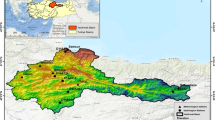Abstract
A model based on neural networks with a teacher is suggested to reconstruct the data of observations of hydrophysical parameters. The indices of global climate oscillations in the ocean–atmosphere system were used as input signals for the model. The processes of model training and adaptation, permitting the most accurate solution of the modeling problem, is described. A comparison of model-predicted monthly mean of the Danube runoff volumes with observational data showed their good agreement. Gaps in data of observations of the water transparency (visibility depth of a white disk) in different years are filled by reconstructed data. A close correspondence in absolute value between reconstructed and measured visibility depths of the white disk is reported. Some features of interannual variations in reconstructed data on water transparency, caused by both climatic factors during 1950–1962 and changes in the chlorophyll а concentration during 1998–2010, were revealed.
Similar content being viewed by others
References
A. S. Kukushkin, “Long-term and seasonal variability of transparency distribution in surface waters of the north-western Black Sea,” Opt. Atmos. Okeana 26 2, 113–123 (2013).
A. S. Kukushkin, E. N. Voskresenskaya, and V.N. Maslova, “The features of transparency field generation in the upper sea layer of the northwestern Black Sea in the winter-spring period,” Atmos. Ocean. Opt. 24 1, 95–101 (2011).
A. S. Kukushkin, “Effects of the distribution of hydrological and hydrobiological parameters on the structure of transparency field in the upper layer of the Black Sea pelagic zone,” Rus. Meteorol. Hydrol. 38 7, 486–495 (2013).
S. Osovskii, Neural Networks for Data Processing (Finansy i statistika, Moscow, 2002) [in Russian].
V. V. Efimov and V. L. Pososhkov, “Application of the method of artificial neural networks to the downscaling of precipitation forecasts in the coastal region of the Black Sea,” Phys. Oceanography 16 3, 141–152 (2006).
V. L. Pososhkov, “The use of artificial neural networks for statistical estimation of the daily mean precipitation series,” in Systems for Environmental Control (Marine Hydrophysical Institute, NAS of Ukraine, Sevastopol, 2002) [in Russian].
V. L. Pososhkov and A. V. Prusov, “The use of SOM method in the analysis of extreme precipitation,” in Systems for Environmental Control (Marine Hydrophysical Institute, NAS of Ukraine, Sevastopol, 2003) [in Russian].
V. V. Efimov and M. V. Shokurov, “The use of artificial neural tenworks for statistical estimation of the Black Sea surface temperature,” in Proc. of the International Conference Devoted to the 75th Anniversary of Academician G.I. Marchuk and the 20th Anniversary of the Institute of Computational Mathematics (ICM RAS, Moscow, 2000), vol. 2 [in Russian].
A. B. Polonskii, E. N. Voskresenskaya, and V. L. Pososhkov, “Statistical forecast of the monthly mean flow of black sea rivers on the basis of circulation processes in the atmosphere,” Dopovidi NAN Ukrainy, No. 11, 95–101 (2010).
A. S. Lubkov, E. N. Voskresenskaya, and A. S. Kukushkin, “Retrieval of sea water transparency values from neural network simulation,” in Proc. of XX Interm. Symp. “Atmospheric and Ocean Optics. Atmospheric Physics (Publishing House of IAO SBA RAS, Tomsk, 2014) [in Russian].
Climate. Patterns and Center. Prediction. http://www.cpc.ncep.noaa.gov/data/teledoc/telecontents.shtml. Cited December 10, 2014.
http://jisao.washington.edu/pdo/PDO.latest. Cited December 10, 2014.
Index. Oscillation. http://www.bom.gov.au/climate/current/. Cited December 10, 2014.
S. Haykin, Neural Networks, a Comprehensive Foundation (Macmillan College Publishing Company, New York, 1994).
F. Rosenblatt, Principles of Neurodynamics: Perceptrons and the Theory of Brain Mechanisms (Spartan, New York, 1962).
A. S. Monin, Hydrodynamics of Atmosphere, Ocean, and Earth Crust Interior (Gidrometeoizdat, St. Petersburg, 1999) [in Russian].
M. K. Muleta, “Model performance sensitivity to objective function during automated calibrations,” J. Hydrologic Engin. 17 6, 756–767 (2012).
A. N. Kolmogorov, “Representation of continuous functions of several variables as the superposition of continuous functions of one variable and addition,” Dokl. Akad. Nauk SSSR 114 5, 953–956 (1957).
R. Hecht-Nielsen, Neurocomputing (Addison Wesley, Amsterdam, 1991).
Author information
Authors and Affiliations
Corresponding author
Additional information
Original Russian Text © A.S. Lubkov, E.N. Voskresenskaya, A.S. Kukushkin, 2016, published in Optika Atmosfery i Okeana.
Rights and permissions
About this article
Cite this article
Lubkov, A.S., Voskresenskaya, E.N. & Kukushkin, A.S. Method for reconstructing the monthly mean water transparencies for the northwestern part of the Black Sea as an example. Atmos Ocean Opt 29, 457–464 (2016). https://doi.org/10.1134/S1024856016050092
Received:
Published:
Issue Date:
DOI: https://doi.org/10.1134/S1024856016050092




